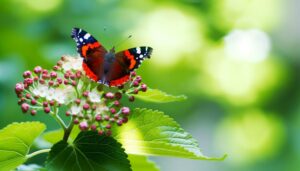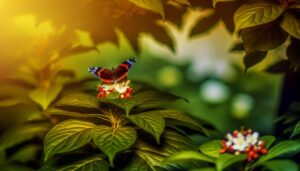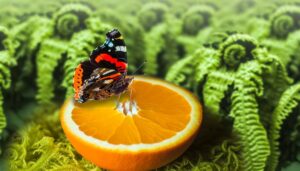Why Are There So Many Red Admiral Butterflies This Year?
The surge in Red Admiral butterflies this year can be scientifically explained by several interrelated factors. Mild temperatures and ideal precipitation have created prime habitats, extending growing seasons and boosting plant density.
An abundance of nectar-rich blooms and host plants, such as stinging nettles, guarantees a reliable food supply. Additionally, reduced predator populations, due to pesticide use and climate change, have led to fewer threats.
This year's favorable conditions have also enhanced migration success and breeding rates. For a deeper understanding of these contributing factors, further exploration into these ecological dynamics is crucial.
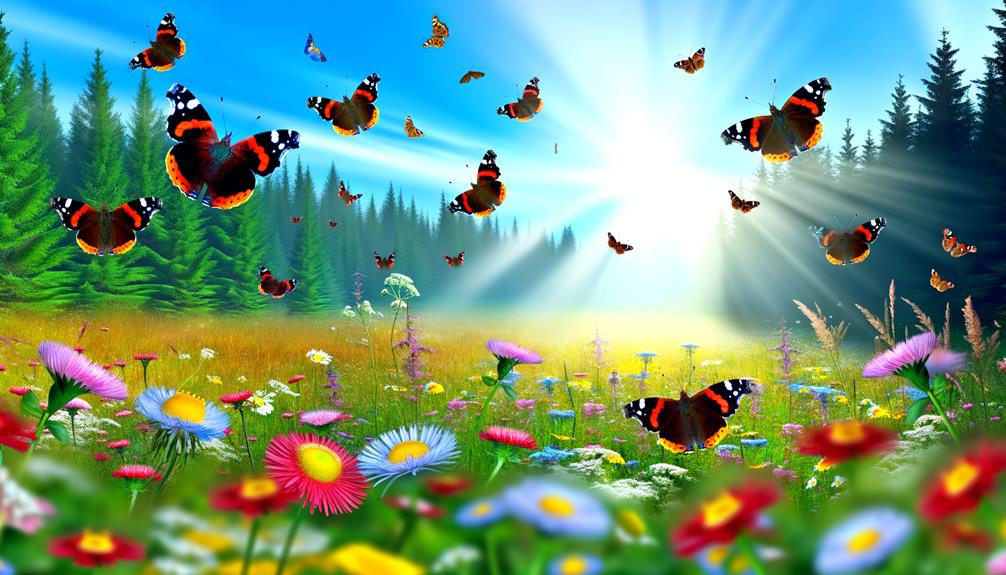
Key Takeaways
- Favorable weather conditions, including mild temperatures and ideal precipitation, enhance Red Admiral butterfly survival and reproduction.
- Abundant nectar-rich flower blooms and host plants provide essential food sources for both larvae and adult butterflies.
- Increased food availability due to prolific growth of nettles and extended blooming periods supports larger butterfly populations.
- Reduced predator populations, influenced by pesticide use and habitat loss, allow more butterflies to thrive.
Favorable Weather Conditions
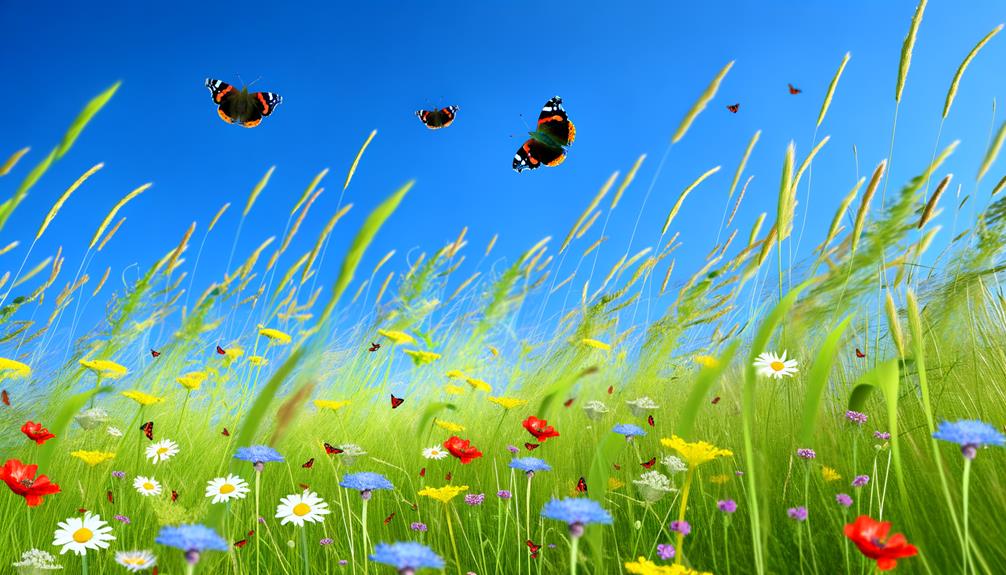
This year, the proliferation of Red Admiral butterflies can be primarily attributed to a combination of unusually mild temperatures and ideal precipitation levels.
These favorable weather conditions have created an advantageous environment for their life cycle stages, including egg laying, larval development, and adult emergence.
Mild temperatures have reduced the mortality rate during the vulnerable developmental phases, while consistent precipitation has guaranteed the availability of moist habitats and vegetation necessary for larval feeding and growth.
Additionally, these conditions have facilitated earlier and more frequent mating cycles.
The synergy of these climatic factors has culminated in a significant increase in the population density of Red Admiral butterflies, as evidenced by numerous field observations and entomological studies conducted throughout the year.
Abundant Food Sources
The proliferation of nectar-rich flower blooms has greatly contributed to the thriving population of Red Admiral butterflies this year.
Additionally, the abundance of host plants essential for larval development has further supported their lifecycle.
These factors, combined with favorable climate conditions, create an ideal environment for the sustenance and growth of this species.
Nectar-Rich Flower Blooms
Numerous nectar-rich flower species, such as Buddleia and Echinacea, have experienced prolific blooms this year, providing an abundant food supply for Red Admiral butterflies.
The increased availability of these flowering plants can be attributed to favorable climatic conditions, including ideal temperatures and precipitation patterns. These conditions have facilitated extended blooming periods, thereby sustaining nectar flow for longer durations.
Additionally, the widespread cultivation of these plants in urban and suburban gardens has amplified their accessibility. Such an environment guarantees that Red Admiral butterflies have constant access to high-energy food sources, vital for their survival and reproduction.
This abundance of nectar-rich blooms directly correlates with the observable rise in Red Admiral populations, underscoring the significance of floral resources in butterfly ecology.
Prolific Host Plants
A notable increase in the availability of prolific host plants, such as stinging nettles (Urtica dioica) and false nettles (Boehmeria cylindrica), has played a critical role in supporting the larval stages of Red Admiral butterflies.
These host plants provide essential nutrients and a conducive environment for the larvae to thrive. The abundance of these specific flora increases the likelihood of successful larval development, directly influencing population growth.
Ecological surveys indicate a correlation between higher concentrations of these host plants and elevated butterfly numbers. Additionally, the resilience and widespread distribution of these plants guarantee a stable and continuous food supply.
This botanical abundance, consequently, creates a strong foundation for the observable surge in Red Admiral populations.
Favorable Climate Conditions
Favorable climate conditions have greatly contributed to the proliferation of abundant food sources, thereby bolstering the sustenance and survival rates of Red Admiral butterflies. Mild temperatures and consistent rainfall have led to the flourishing of various nectar-rich plants and host plants such as nettles, which are essential for the larvae. The availability of these resources guarantees that Red Admirals can thrive at different life stages.
Scientific observations indicate that climate-induced changes have resulted in:
- Extended growing seasons: More prolonged periods for plant growth and nectar production.
- Increased plant diversity: A wider array of flowering plants available.
- Higher plant density: Greater quantities of food sources in concentrated areas.
These factors collectively enhance the overall ecosystem, supporting a larger Red Admiral population.
Migration Patterns

Understanding the migration patterns of Red Admiral butterflies requires a detailed analysis of their seasonal movements, environmental triggers, and geographical pathways. These butterflies exhibit a remarkable migratory behavior, traveling vast distances between their breeding and overwintering grounds. Environmental factors such as temperature, day length, and food availability play essential roles in initiating migration.
The following table outlines key aspects of their migration:
| Factor | Description |
|---|---|
| Seasonal Movements | Northward in spring, southward in autumn |
| Environmental Triggers | Temperature changes, photoperiod, food scarcity |
| Geographical Pathways | North America, Europe, Asia |
Understanding these patterns provides insight into the reasons behind the increased presence of Red Admiral butterflies this year, as favorable conditions may enhance their migration success.
Breeding Success
Breeding success in Red Admiral butterflies is intricately linked to factors such as habitat quality, availability of host plants, and climatic conditions. Ideal breeding conditions this year have contributed considerably to their increased population. Several key elements have facilitated this:
- Habitat Quality: Well-preserved environments with abundant nectar sources support higher reproduction rates.
- Host Plant Availability: Increased growth of host plants like nettles guarantees ample food for larvae.
- Climatic Conditions: Favorable temperatures and reduced precipitation have enhanced survival rates of eggs and larvae.
These factors collectively influence the reproductive output, thereby leading to a noticeable surge in the Red Admiral butterfly population this year.
Predator Absence

The notable reduction in predator populations this year has greatly influenced the resurgence of Red Admiral butterflies.
Changes in habitat, particularly the decline of natural predators, have created a more conducive environment for these butterflies to thrive.
Additionally, the increased availability of food sources further supports their population growth and stability.
Reduced Predator Population
A notable decline in the population of natural predators has considerably contributed to the increased sightings of Red Admiral butterflies this year. This phenomenon can be attributed to several factors impacting predator species, leading to an ecological imbalance.
The absence of these predators has allowed Red Admiral larvae and adults to thrive, leading to a noticeable surge in their population. Key factors influencing predator decline include:
- Pesticide Use: Widespread pesticide application has reduced predator numbers.
- Climate Change: Altered weather patterns have disrupted predator-prey dynamics.
- Habitat Loss: Urbanization and deforestation have diminished predator habitats.
This reduction in natural checks on the Red Admiral population underscores the complex interplay within ecosystems.
Changes in Habitat
In the absence of natural predators, the habitats of Red Admiral butterflies have undergone significant changes that have facilitated their population growth. The reduction in predation pressure has allowed these butterflies to exploit a broader range of ecological niches, contributing to their increased numbers. This phenomenon can be analyzed through specific habitat attributes such as vegetation density, microclimate stability, and breeding site availability.
| Habitat Attribute | Before Predator Decline | After Predator Decline |
|---|---|---|
| Vegetation Density | Moderate | High |
| Microclimate Stability | Variable | Stable |
| Breeding Site Availability | Limited | Abundant |
This table elucidates how the absence of predators has led to denser vegetation, more stable microclimates, and increased breeding sites, thereby supporting higher Red Admiral butterfly populations.
Increased Food Availability
As the habitats of Red Admiral butterflies have flourished in the absence of natural predators, an accompanying increase in food availability has further facilitated their population expansion. This phenomenon can be attributed to several ecological factors, resulting in an environment conducive to their proliferation. The increased availability of essential resources has had a significant impact on their life cycle and reproductive success.
- Proliferation of host plants: Nettles, a primary food source for Red Admiral larvae, have seen remarkable growth.
- Abundance of nectar sources: Adult butterflies benefit from an increased supply of nectar-producing flowers.
- Reduced competition: With fewer predators, there is less competition for food resources.
These factors collectively contribute to the surge in Red Admiral butterfly numbers.
Human Impact
Human activities, particularly urbanization and pesticide use, have markedly altered the habitats and populations of Red Admiral butterflies. Urban expansion leads to habitat fragmentation, reducing the availability of native host plants required for larval development.
Pesticides, especially neonicotinoids, negatively impact both larval and adult stages by contaminating food sources and reducing survival rates.
However, some urban gardens and green spaces inadvertently create refuges rich in nectar plants, facilitating population growth. Additionally, climate change driven by human activities has extended the growing season, allowing multiple generations per year.
Consequently, while human impact is generally detrimental, certain anthropogenic changes have also contributed to the observed rise in Red Admiral butterfly numbers this year.
Conclusion
The proliferation of red admiral butterflies this year can be attributed to a confluence of factors including favorable weather conditions, abundant food sources, advantageous migration patterns, successful breeding, and a notable absence of predators. This surge in their population has sparked curiosity among researchers and nature enthusiasts alike, leading to discussions on ecological impacts and conservation efforts. Some have even begun asking, “how much is a red admiral,” as interest in butterfly conservation and collection grows. With their striking coloration and increased numbers, these butterflies have become a captivating sight in gardens and natural habitats across the region.
The impact of human activities, particularly in creating conducive environments, cannot be overstated.
This year's explosion of red admirals is an extraordinary demonstration of the delicate balance of ecological factors that, when perfectly aligned, result in such a spectacular natural phenomenon.

